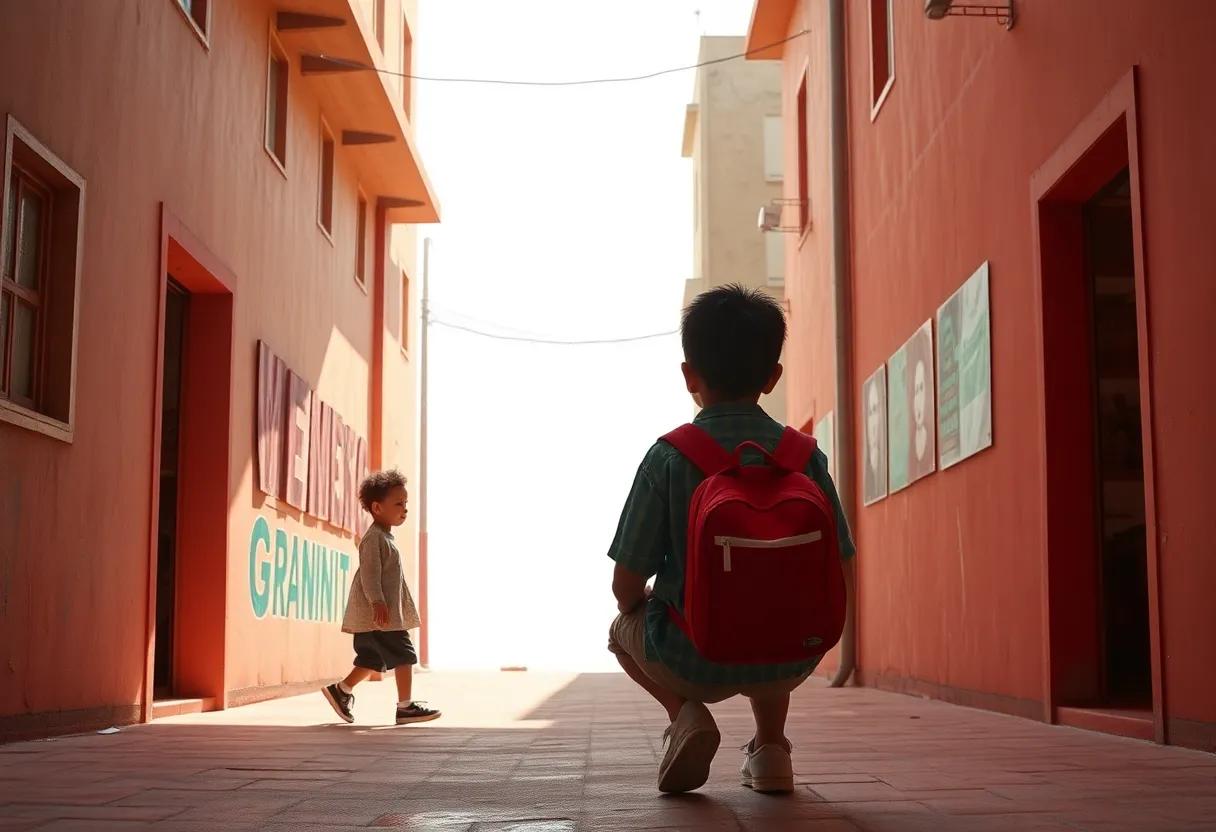In an era where the complexities of cultural identity resonate more deeply than ever, Rafael Polo’s Growing Up American emerges as a compelling narrative that delves into the intricate dance between heritage and assimilation. Navigating Identity and Heritage: A Review of Growing Up American explores polo’s evocative portrayal of the immigrant experience, inviting readers to reflect on the nuanced challenges and revelations that accompany the journey of defining oneself amid contrasting worlds. This review aims to unravel the layers of Polo’s storytelling, examining how his work captures the delicate balance of honoring one’s roots while forging a new path in a diverse society.
Exploring the Complexities of Bicultural Identity in Growing Up American and Its Impact on Personal Growth
navigating bicultural identity often feels like walking a tightrope between two distinct worlds. Rafael Polo delves deeply into this tension, illustrating how first- and second-generation Americans wrestle with their heritage while striving for social belonging. This duality fosters a unique form of personal growth, where individuals forge hybrid identities that combine tradition with adaptation. For many, this journey means reconciling the expectations of family and community with the desire for self-expression, often leading to moments of both internal conflict and profound self-revelation.
The book emphasizes that the impact of bicultural identity extends beyond mere cultural navigation-it’s a catalyst for developing resilience, empathy, and nuanced worldviews. Polo highlights several key factors influencing this growth:
- Language fluency: Balancing native tongues with English nuances.
- Community ties: Maintaining cultural rituals while engaging with broader society.
- Generational expectations: Balancing parental values with personal ambitions.
- Identity negotiation: Creating a personalized cultural synthesis.
These elements combine to create a lived experience that is complex but rich in potential, underscoring how bicultural Americans often become bridges between cultures, enriching both their communities and their own sense of self.
| Aspect | Challenge | Growth Possibility |
|---|---|---|
| Language | Language loss or confusion | Bilingual skills & cognitive flexibility |
| Family | Conflicting cultural expectations | Stronger family connections & negotiation skills |
| Community | Sense of marginalization | Expanded social networks & empathy |
The Role of Family Traditions and Heritage in Shaping the Protagonist’s Journey Toward Self-Understanding
Rafael Polo masterfully weaves the intricate tapestry of family traditions and heritage throughout the protagonist’s transformative journey. It is within the confines of ancestral rituals,shared stories,and unspoken values that the character begins to unravel the complexities of identity and belonging.These cultural touchstones act not only as a tether to the past but also as a mirror reflecting the evolving self. The protagonist’s encounters with family customs-some celebratory, others challenging-highlight the friction and fusion between generations, illuminating how heritage can both anchor and propel personal growth.
- rituals and Celebrations: Moments that reinforce community bonds and cultural pride.
- Oral Histories: Stories passed down that shape perceptions of identity and resilience.
- Intergenerational dialog: conflicts and reconciliations between old-world perspectives and new-world realities.
Through this blend of tradition and self-exploration, Polo presents heritage as a dynamic force rather than a static inheritance. The protagonist’s navigation involves questioning inherited beliefs and selectively embracing elements that resonate with their emerging sense of self.To visualize this journey, consider the table below outlining key family influences and their impact on the protagonist’s evolving identity:
| Family Tradition | Emotional Resonance | Effect on Identity |
|---|---|---|
| Sunday dinner Rituals | Comfort & Belonging | Strengthens cultural roots |
| ancestor Storytelling | Pride & Reflection | Encourages self-reflection |
| Religious Observances | Conflict & Reconciliation | Challenges beliefs, fosters growth |
How Growing Up American Portrays the Interplay between Assimilation Pressures and Cultural Preservation
Rafael Polo masterfully delves into the nuanced reality faced by many immigrant families,where the desire to integrate into American society often conflicts with the need to maintain one’s cultural roots. Through vivid anecdotes and insightful analysis, the book reveals how assimilation pressures do not simply erase heritage but rather create a dynamic tension that shapes identity formation. Children growing up in this liminal space frequently experience a push-and-pull between embracing new norms-language, social expectations, educational goals-and honoring traditions passed down by their elders. This delicate balance is portrayed not as a linear process but as an ongoing negotiation, challenging the notion of assimilation as complete conformity.
Key elements highlighted include:
- The role of family in preserving native languages and customs
- The impact of peer influence and schooling on cultural adaptation
- The emotional complexity of navigating dual identities
| aspect | Assimilation Pressure | Cultural Preservation |
|---|---|---|
| Language | Adoption of English as primary mode of communication | Use of native languages at home and in community |
| Social Norms | Conforming to American behavioral expectations | Upholding family rituals and celebrations |
| Identity | Fitting into mainstream culture | Maintaining connection to heritage and ancestry |
A Deep Dive into the Emotional challenges Faced by Immigrant Children Navigating Two Distinct Worlds
Immigrant children often find themselves caught between two cultures, each with its own expectations and values. The emotional turbulence that arises from this duality is profound, as these young individuals grapple with a sense of belonging that can feel perpetually out of reach. Polo captures the essence of this internal struggle through vivid anecdotes and heartfelt reflections, illuminating the complex navigation between heritage and assimilation. The pressure to honor familial roots while fitting into a new societal mold can create an ongoing tension, leading to feelings of isolation, identity confusion, and sometimes, silent resilience.
The emotional challenges can be categorized into several interwoven themes, including:
- Language barriers that hinder authentic self-expression and connection.
- The weight of expectations from both parents and peers, demanding success in unfamiliar environments.
- A persistent fear of rejection or alienation from either cultural community.
- The struggle to reconcile customary values with the norms of the host culture.
To further illustrate, consider the emotional impact through this simple comparison table:
| Emotional Challenge | Manifestation | Potential impact |
|---|---|---|
| Dual Identity Conflict | Feeling “not enough” in either culture | Low self-esteem, anxiety |
| Family Expectations | Pressure to succeed academically or culturally | Stress, burnout |
| social Exclusion | Marginalization by peers | Loneliness, depression |
The Narrative Structure and Literary devices That Enhance the Authenticity of Cultural Experience
Growing Up American masterfully employs a non-linear narrative that mirrors the fragmented nature of memory and identity.Rafael Polo’s strategic interplay between past and present moments invites readers to piece together the protagonist’s evolving self-awareness in a manner that feels both intimate and authentic. This structure not only reflects the complex layering of cultural inheritance but also foregrounds the emotional dissonance experienced by many first-generation immigrants. polo’s use of vivid snapshots-a technique that offers brief but powerful glimpses into formative moments-enhances the visceral connection to heritage while emphasizing how the past continually informs the present.
Moreover, the novel is rich with literary devices that deepen the texture of cultural experience.Symbolism appears subtly yet effectively; for example, traditional foods, language shifts, and family heirlooms recur throughout the text, acting as tangible anchors to a fading homeland. The deft use of code-switching between English and Spanish bolsters authenticity, exposing the linguistic duality that shapes identity. Growing Up American also leverages sensory imagery-such as the scents of markets or the sounds of festivals-that immerses readers in the protagonist’s world,making cultural transmission not just a theme but a palpable experience.
Themes of Belonging and Alienation Explored Through Vivid Storytelling and Relatable Characters
Rafael Polo’s narrative deftly captures the intricate dance between the desire to belong and the sting of alienation that many second-generation immigrants experience. Through Growing Up american, readers are invited into the textured world of relatable characters whose inner conflicts reveal universal truths about identity and acceptance.The novel’s vivid storytelling brings to life the everyday moments-the whispered conversations in two languages, the clash of cultural expectations, and the solitary reflections under the vast American sky-that define the liminal space between heritage and assimilation. These elements anchor the characters in a palpable reality, drawing empathy from readers who find echoes of their own journeys in the pages.
At the heart of Polo’s work lies a delicate balance, showcased by the characters’ varied responses to their dual identities. Some embrace their heritage boldly, while others wrestle in silence, trying to reconcile the contrasting demands of family and society. this dynamic is underscored by a subtle but powerful exploration of community and isolation, reflected in moments such as:
- Family gatherings charged with both warmth and unspoken tensions
- Schoolyard friendships that bridge cultural divides yet highlight differences
- Internal dialogues grappling with feelings of invisibility and hypervisibility
| Character | Sense of Belonging | Key Moment |
|---|---|---|
| Maria | Strong cultural pride | Leading a community festival |
| Javier | Conflicted identity | Silent withdrawal at family dinner |
| Elena | Struggles with acceptance | School art project on heritage |
This nuanced portrayal not only humanizes the immigrant experience but also invites readers to reflect on their own perceptions of identity, place, and the elusive feeling of “home.” The emotional truth resonating through these stories transforms Growing Up American into more than just a novel; it becomes a mirror for anyone navigating the delicate tapestry of belonging and alienation.
The Significance of language and Communication in Bridging Generational and Cultural Divides Within the Book
Language acts as both a bridge and a barrier in Growing Up American, poignantly illustrating the intricate dance between generations and cultures. Polo masterfully depicts how the protagonist’s ability to fluently navigate English and Spanish symbolizes a deeper connection to dual identities, challenging the often rigid confines of cultural assimilation. The nuanced dialogue throughout the narrative reveals unspoken tensions and heartfelt reconciliations, emphasizing how communication transcends mere words to embody understanding, respect, and empathy between family members with differing worldviews.
Within these pages, communication unfolds in various forms, each serving distinct purposes:
- Verbal exchanges: Dialogue brimming with cultural idioms and generational slang highlights contrasts and common ground.
- Non-verbal cues: Gestures, silences, and expressions that convey what words fail to express, especially during moments of conflict or vulnerability.
- Written communication: Letters and diary entries function as private spaces for identity exploration and emotional honesty.
| Communication Form | Role in Bridging Divides |
|---|---|
| Language Fluency | Facilitates cultural identity and acceptance |
| Intergenerational Dialogue | Unlocks empathy and shared understanding |
| Non-verbal Expression | Reveals unspoken emotions and respect |
Through these lenses, Polo invites readers to contemplate how language and communication are not static vessels but evolving tools that foster connection across time, culture, and experience.
Integrating Historical Context to Enrich Readers’ Understanding of Immigrant Experiences in America
Rafael Polo masterfully weaves historical events and personal narratives, allowing readers to place individual immigrant stories within a broader American tapestry. By contextualizing the waves of migration through specific decades - from the labor-driven influx in the early 20th century to the new challenges of the post-1965 immigration reforms - the book offers a dynamic timeline that deepens recognition for the shifting socio-political landscapes immigrants navigated. This layering of history not only enhances comprehension of the struggles and triumphs depicted, but also emphasizes the resilience and adaptability demanded of new Americans across generations.
To further enrich this exploration, Polo highlights key themes embedded in the immigrant experience, such as:
- Cultural Preservation: how traditions are maintained or transformed within diasporic communities
- Identity Conflict: the tension between assimilation and heritage pride
- Economic Mobility: the pursuit of the elusive American Dream
- Social Barriers: institutional challenges and discrimination faced
each segment is supported by vivid anecdotes and statistical insights, creating a connective tissue that marries fact with feeling. Consider the snapshot below, wich summarizes pivotal immigration periods and their defining characteristics as depicted in Growing Up American:
| Era | Primary Immigrant groups | Key Challenges | Impact on Identity |
|---|---|---|---|
| 1900-1920 | Southern & Eastern europeans | Industrial labor exploitation, language barriers | Strong ethnic enclaves, cultural retention |
| 1965-1980 | Latin American, Asian migrants | Legal reforms, shifting racial dynamics | Dual identity conflicts, political activism |
| 1980-Present | Refugees, diverse economic migrants | Immigration policy tightening, social integration | Hybrid identities, transnational ties |
Practical Recommendations for Readers Seeking to Connect with Their Own Heritage Through Growing Up American
Engaging with your heritage while navigating the complexities of American identity requires intentionality and openness. Start by immersing yourself in cultural traditions-whether it’s cooking family recipes, attending cultural festivals, or learning the native language. These small yet meaningful acts create a bridge between your roots and your present life. Equally important is seeking out stories from older generations; interviews, family photo albums, or handwritten letters offer priceless insights that textbooks may overlook.
To maintain a balanced connection, integrate heritage exploration with community involvement. Join cultural groups or local heritage organizations to surround yourself with like-minded individuals sharing similar experiences. This amplifies feelings of belonging without losing personal uniqueness. Consider using the table below as a simple guide to balance heritage practices with modern American life:
| Heritage Practice | Modern Integration |
|---|---|
| Traditional Family Recipe | Host potluck dinners blending traditional and American dishes |
| Native Language Study | Use language apps with cultural media (music, films) |
| Cultural Festivals | Volunteer or participate in multicultural fairs |
| Heritage Storytelling | Create digital memoirs or blogs |
- Reflect regularly: Write journal entries exploring your feelings around identity shifts.
- Celebrate hybrid identities: Embrace moments where American culture and heritage naturally mix.
- Practice patience: Understanding identity is an evolving journey, not a destination.
How Growing Up American Serves as a Valuable Resource for Educators Addressing Multiculturalism in Curriculum
Growing Up American offers educators an insightful lens into the diverse experiences that shape the identities of second-generation immigrants. The book’s candid narratives highlight the complexities of balancing heritage and mainstream culture, providing authentic examples that educators can incorporate into their teaching materials. This resource not only deepens cultural understanding but also encourages empathy, helping students from all backgrounds recognize the multifaceted nature of American identity. By weaving these stories into curriculum planning, teachers can create more inclusive classrooms that validate the experiences of multicultural students and foster respectful dialogue.
moreover, Growing Up American functions as a practical tool for curriculum developers aiming to embed multicultural perspectives into various subjects. The book’s approach can be distilled into key educational strategies such as:
- Contextual Storytelling: Using personal stories to humanize historical and social themes.
- Intersectional Analysis: Examining identity through multiple cultural and social lenses.
- Critical Reflection: Encouraging students to reflect on their own cultural narratives alongside others’.
| Educational Focus | Request Example |
|---|---|
| Language Arts | Analyzing immigrant narratives in literature |
| Social Studies | Discussing immigration policies and cultural assimilation |
| Cultural Awareness | Hosting heritage-sharing presentations |
The Balance Between Hope and Struggle Portrayed in the Journey of Self-Discovery and Cultural Acceptance
Rafael Polo masterfully interweaves moments of resilience with glimpses of optimism, illustrating how the personal battle for identity is rarely linear. The protagonist’s journey reveals the complexity of reconciling a rich cultural heritage with the demands and expectations of a new environment, showcasing that struggle is not merely an obstacle but a catalyst for growth. In this narrative, hope emerges not as a naive belief but as a purposeful choice-an anchor amid confusion and rejection. It is this delicate interplay between perseverance and vulnerability that breathes authenticity into the story, making it resonate deeply with readers who have felt caught between worlds.
through vivid storytelling and compelling character advancement, Polo highlights key elements that define the experience of cultural acceptance:
- Inner conflict: The tension between embracing tradition and adapting to change.
- External pressures: Navigating societal stereotypes and expectations.
- Moments of clarity: Epiphanies that redefine self-perception and belonging.
- Community influence: The role of family, friends, and cultural institutions in shaping identity.
Together, these facets compose a nuanced portrait of resilience. to better understand this balance, the table below summarizes key emotional milestones encountered by the protagonist:
| Emotional Milestone | Impact | Symbolism |
|---|---|---|
| Experiencing Alienation | Heightened self-doubt | Isolation from peers |
| Discovering Cultural Roots | Renewed pride | Connection with ancestors |
| Facing Prejudice | Strengthened resolve | Challenge to identity |
| achieving Acceptance | Peace with duality | Harmony of past and present |
Critical Reflection on the author’s Perspective and Its Influence on the Representation of Identity Themes
Rafael Polo’s perspective, deeply rooted in his bicultural experience, shapes the narrative’s nuanced exploration of identity with both poignancy and complexity. his intimate understanding of cultural duality allows him to present identity not as a static label, but as an evolving conversation influenced by family, community, and personal choice. Though, this subjective positioning occasionally narrows the scope, privileging experiences tied closely to Polo’s own upbringing over broader, more diverse interpretations of heritage. This focus enriches authenticity but may inadvertently limit the multiplicity of identities within the american immigrant landscape.
Interestingly, Polo employs a balance of vulnerability and resilience, which manifests in the characters’ struggles and triumphs, emphasizing the fluidity of selfhood.The representation of identity themes is further intricate by the author’s subtle critique of societal expectations, revealing the tension between assimilation and cultural preservation. Below is a brief overview of how Polo’s perspective influences key identity themes:
| Theme | Author’s Influence | representation Outcome |
|---|---|---|
| Cultural Hybridity | Personal bicultural experiences | Rich, internalized cultural conflicts |
| Family Legacy | Emphasis on generational ties | Emotional depth in heritage transmission |
| Assimilation | Critical view of societal pressures | Portrayal of identity negotiation |
- Strength: evocative personal insights create relatable identity struggles.
- Limitation: potential underrepresentation of alternative immigrant experiences.
- Overall: Polo’s perspective offers a compelling but focused lens on identity formation.
An Insightful Look Into Rafael Polo: The Life and Inspirations Behind Growing Up American
Rafael polo’s journey is intricately woven with the threads of identity, heritage, and the search for belonging in a multicultural landscape. His narrative transcends the conventional memoir by delving into the subtle intersections of cultural nuances and personal growth.Through vivid storytelling,Polo brings to life the challenges and triumphs of navigating two worlds-the traditional customs of his family’s roots and the dynamic,frequently enough contradictory,culture of America.His reflections offer a profound dialogue on how identity is not static but a continuous process shaped by memory, environment, and evolving self-perception.
Central to Polo’s story are the themes that resonate deeply with many first- and second-generation Americans.These include:
- Familial Expectations: the delicate balance between honoring one’s heritage and forging an self-reliant path.
- Cultural Duality: Embracing a bicultural identity while frequently enough feeling “in-between” two worlds.
- Language as Legacy: How language preserves tradition but also becomes a tool for integration.
| Theme | Polo’s Perspective | Cultural Reflection |
|---|---|---|
| Identity | Fluid, evolving, personal | Hybrid realities embraced |
| Heritage | Source of strength and complexity | Tradition meets modernity |
| Belonging | Negotiated through dialogue | Community and self-found |
In closing, Growing Up American by Rafael Polo offers a thoughtful exploration of the delicate balance between identity and heritage, capturing the nuances of growing up caught between cultures.Polo’s narrative invites readers to reflect on their own experiences of belonging and self-discovery, making this memoir not only a personal journey but a universal conversation about what it means to find one’s place in the world. Whether you come from a similar background or are simply seeking insight into the immigrant experience, this book leaves you with a quietly resonant understanding of the ties that shape us and the freedoms we strive to claim.









